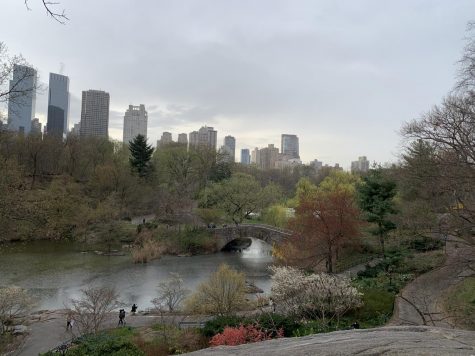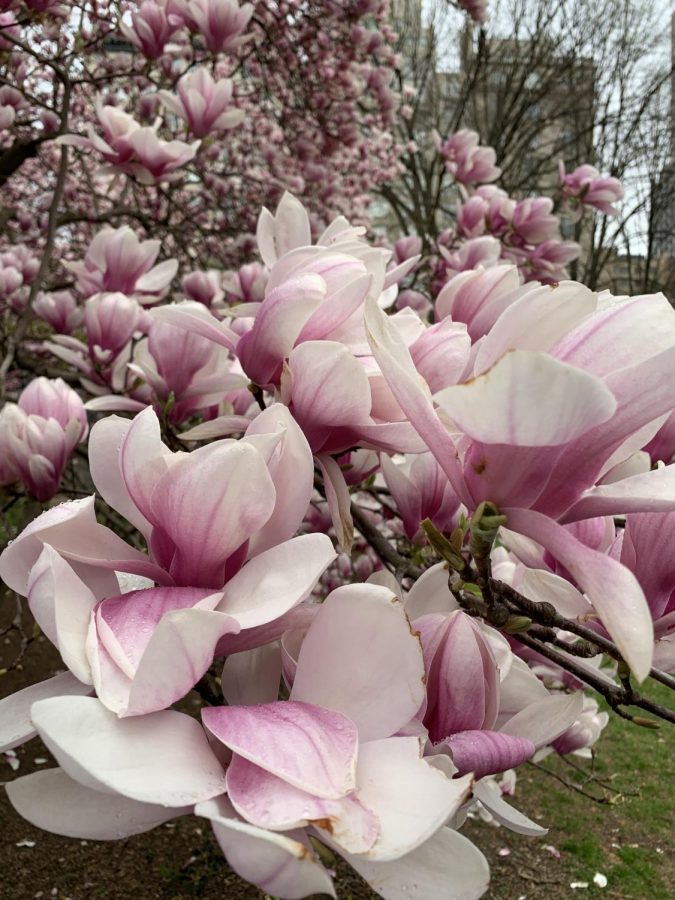A Rhapsody on Nature in New York City
With the season of spring upon us, we can expect to see nature returning to enliven our cityscape.
Magnolias are ancient trees. Their lineage stretches back to fossilized samples dated at some 2 million years old. They have been theorized to have been around for longer than bees, as one of very few flowers dotting the landscape as beetles were the best insects to conduct pollination at the time. This particular plant is the Magnolia x soulangeana, or saucer magnolia. Originally bred by a French plantsman in the early 1820s, it flowers early in the spring, and was planted all over pastoral landscapes in the British Isles. As Frederick Law Olmsted and Calvert Vaux sought to turn Central Park into an English romantic pastoral landscape, it was an easy choice to place this plant in the pre-planned park. It is an imported species to this continent, yet is a prominent feature within Central Park, and an example of its nature, nonetheless.
We New Yorkers live a far cry from the countryside; we live in a northern, cold, industrial landscape molded by people, and yet nature persists. As spring nears, we see a recovery in the canopies dotting the streets of the city, bushes burgeoning with growth, and sidewalks littered with life, as weeds force themself up. Birds return from their wintertime migrations, warming our grey landscape with the bright red crests of Cardinals, and cooling it with the benign Blue Jay. Spring is a beautiful time, though perhaps appreciated from an arm’s length away, for allergies and the cantankerous Canadian Geese return— arguably our worst import from our northern neighbors, as they tend to interrupt this serene scene. To say that they are imported implies an unobtainable control over these creatures. These Geese may see our comings-and-goings as we do theirs, they have traveled these paths for much longer than we have.
Before the towers scraping the sky that pit New York against Shinar, before the melting pot of cultures that it is famous for today, we housed a diverse display of nature. Hills, forests and a long island to the east, marshes, housing some of the most biodiversity of any biome, and a sudden change as you reach the mainland, with forests and cliffs entirely different from any other seen so far. This wilderness was settled only by the bears and salamanders and had visitors consisting solely of whales and dolphins.
While towering trees have been traded out for titanic towers that scrape the heavens, some of those earliest residents remain yet. Raccoons, curious little creatures clever enough to wash their belongings, squirrels cunningly running in any park, and a plethora of plumaged pigeons, and the lonesome coyote in Central Park. Even if our interactions with these creatures are scarcer than sightings of the mythical mothman in West Virginia, we have a constant and persistent, though usually invisible, impact on these creatures.
Nature has persisted through our developments, both by pushing nature out, and introducing new nature. Rats, for better or for worse, are iconic and common in our cityscape, but are not native to this region or even this continent. They made the difficult journey with Europeans some centuries ago, an unknown and undetected guest that had terrified and decimated an entire continent centuries more, and now have become, at the worst, a daily sight that makes you jump, and at the best, pizza connoisseurs. Cats have done the same, and New York’s strays have become so well known to inspire play. Those weeds that persist against our attempts at sheets of rock similarly are of foreign origin, such as dandelions, which in the summer push up and gift us yellow petals against a gray cityscape.
These species have become so integral to New York that they are not even quantified or condemned under the title of ‘invasive.’ Those forests and hills became farm ground to the east, and as the city grew quickly were paved over for our urban Queens, yet nature continues to persist. The central island had its marshes paved over, preserving a central park. Even then, this mash-up of swamps, boulders and bluffs of stone, was already settled. People were displaced to preserve this portion, though preservation is a bit disingenuous, as the park was quickly reshaped to look more like a European pastoral landscape.
This pseudo-pastoral place is Central Park, which is seen as one main major place where nature can truly shine in New York City, but knowing that it was manufactured by people, does that change how we should view it as nature? It was a microcosm of marshes and more, and it was paved over for appearances. The city was already forcing out nature, and what was left behind was totally changed to be an ideal, an attempt at erasing the nature that existed before. Even so, nature has persisted with what it was left with. The remains of what was adapted to what is, as recently as February 2021, coyotes were spotted in Central Park, and without this, admittedly warped, rectangle of nature, our cityscape would be all the grayer. Even if it is groomed to an ideal, it still should be preserved.

(Scott Ernsberger)
We have a direct impact on the nature around us, and even if it is not as blatant as paving over marshes, it is an innate and constant consequence of existence. A modern analogue may be littering, but there are, in many cases, more pressing issues. The invasive species that we have introduced are a problem that we have posed and must solve. Cats, as great as they are, can be awful. Their introduction was an indirect result of people, and cats have a dire impact on wild nature. They are one of a few species that hunt for fun, not just survival, and given the unchecked nature of the city, they hunted several species of birds to extinction. These are songs that will no longer sweep through our streets, and progress should be made to keep the remaining avian population present.
Not every disaster that has befallen nature is the fault of people, and those too, we must attempt to fight against. Canine distemper virus is a horrible epidemic that has been sweeping through specific parts of the nation, and has unfortunately come to nest in our city. In recent years, there was an outbreak in Ohio. In closer years, it was found sparsely in the Bronx. This escalated to a breakout, a breakout that has spread through every borough, sparing only Staten Island. The impacts that it has on native wildlife and, as the name implies, canines, and poses a threat to dog owners throughout the city.
Distemper is effectively untreatable and passed unto the unfortunate recipient through fleas. Once infected, the afflicted animal can pass it through bodily fluids to others. As if the fleas already were not a major issue, distemper affects many body systems, from the stomach to the spinal cord. Mortality rates are at a guaranteed 100% for non-vaccinated ferrets, and high across the board for other pets, and even after vaccination it is still very dangerous, to say nothing of the danger posed to the non-inoculated population of wild animals.
While the last of the snow was melting away some weeks ago, a very sick Raccoon came to my porch. I was in-between my Zoom classes, and saw it precariously perched. It seemed almost like a large squirrel at first, for it was but skin and bone, and the typically bushy tail of raccoons had become thin, offering no protection from the environment. It moved slowly and sluggishly, pausing a moment to sit on a porch chair to bask in the sun. I had seen raccoons before, during late walks in the night, you can expect to see them walking about alleyways, always searching for something. To see one in broad daylight was concerning, and as I could get a better look at him, my concern grew. The raccoon was bald from his shoulders to the top of his head, due to mange caused by the fleas. I prepared a small bowl of dry cat food and water for him, which he used his strangely human hands to grasp and shove into his mouth. To give him the dishes, I had to tap on the floor until he turned over to face me and I could see into his eyes. They were white, glossed over and full of remorse. It truly broke my heart to see such a creature in such a condition, left sickly and blind.
Raccoons truly are wonderful creatures. In German, their name translates to “wash bear,” because of their compulsion to wash objects they claim as their own, making them rather clean creatures. This, alongside their sharp wit, has no doubt lead to the conception of them as mischievous. They are native to the Americas, and were hunted for their fur in the 1700s and 1800s, with some being brought back to Europe for their furs. In some divine sense of comedy, a major factory in Germany was bombed during the World Wars, releasing thousands of racoons into the countryside, from where they have fanned out. They wasted no time in stirring trouble, and have caused millions of dollars in property damage over the years, striking enough fear to ordain a meeting in Scotland upon a single raccoon being seen in their nation.
It took hours of calling animal control before we could get any help, and when they came we had to re-discover the raccoon. I found him a block away in a tall green garbage bin that he seemingly had not the strength to escape. The animal control worker confirmed the situation, and took the raccoon away, to a better place, to the garden in the east. I learned then, that there are two Animal Control vans for all of the five New York City boroughs, and how horribly underprepared we are for major threats such as distemper.
Of course, distemper is the not the most pressing virus that we must face right now, but it is nonetheless a major threat which is being all but ignored, to say nothing of our unpreparedness towards it. Nature, for all its beauty, is flawed and unstable. If it is pushed in one way by ourselves, we must then try to stabilize it.
We have a direct impact on the nature around us, and even if it is not as blatant as paving over marshes, it is an innate and constant consequence of existence.
Scott Ernsberger is a Managing Editor/Advisory Editor for ‘The Science Survey.' As a Managing Editor, Scott helps with copy-editing and keeping deadlines,...











